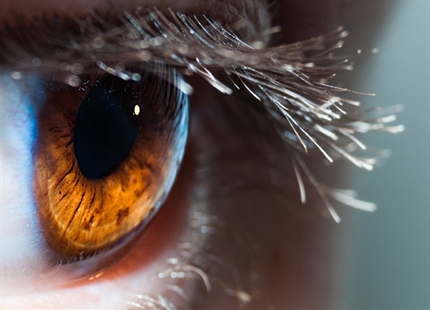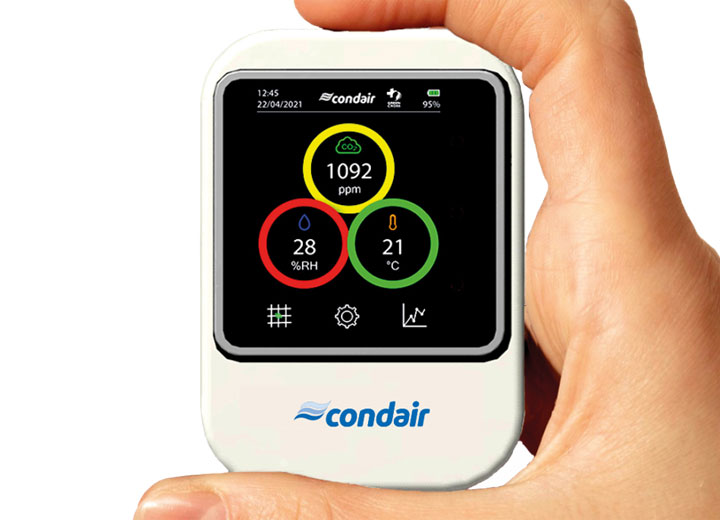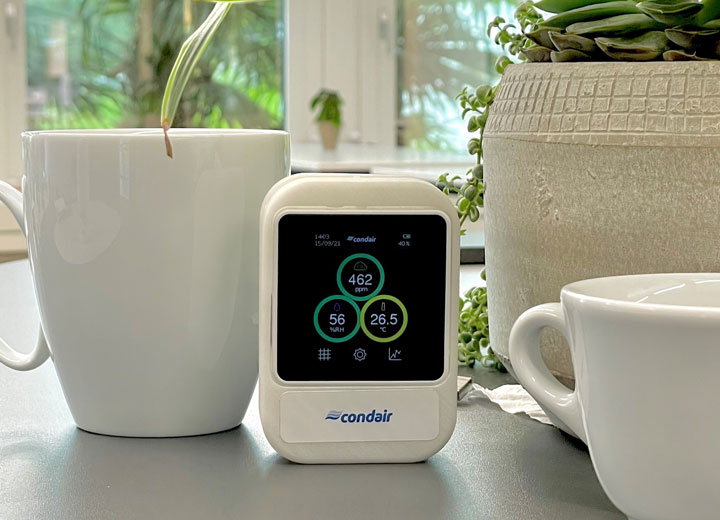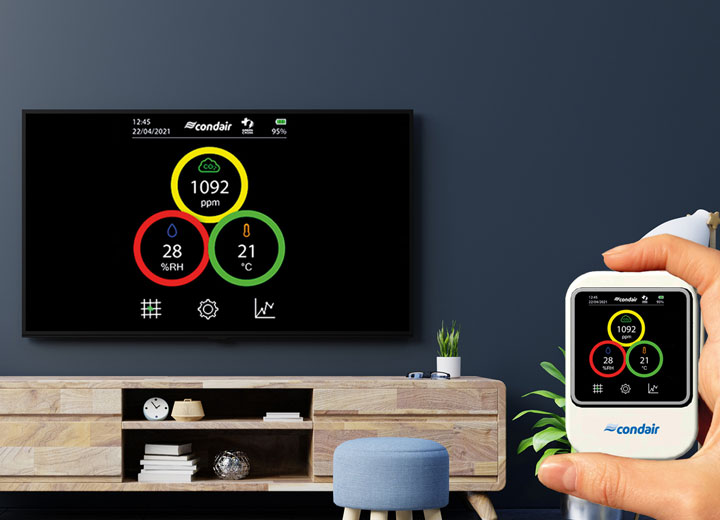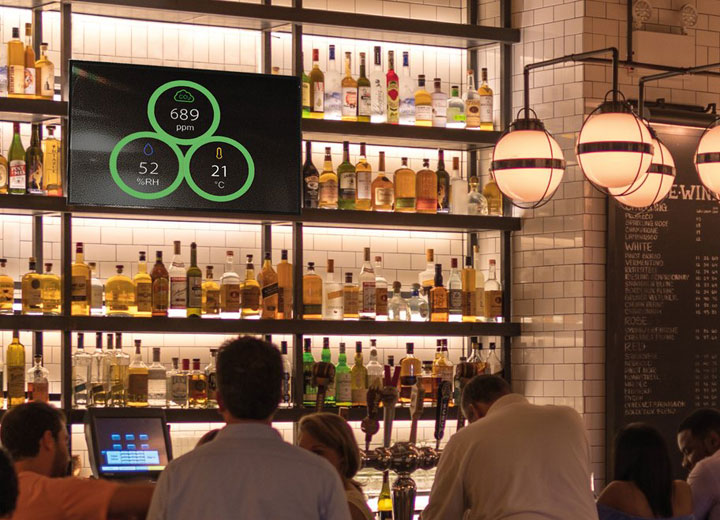
Condair Cube - indoor air quality monitor
This compact device monitors and displays the CO2, humidity and temperature levels of a room. A straight forward traffic light system provides clear and immediate guidance on whether a room's indoor air quality is inline with recommended levels. This allows the occupants or a building manager to take action and mitigate the risks of airborne viral transmission.
The Condair Cube can be powered via a USB cable (provided) or operated on its rechargable battery for up to four hours. By connecting the device to a laptop, via the USB cable and app (link below), the display can be mirrored on to a TV or monitor.
The Condair Cube's readings can be displayed in either numerical or graph formats. A touch screen display provides control over operation. Readings can be recorded via a micro memory card (not provided) so that an area's historic air quality can be objectively reviewed in Excel. This can help identify when improvements are required or highlight necessary changes to a room's occupancy or use.
£200 inc vat & delivery to mainland UK
-
The recommended CO2 level for an occupied area is less 800ppm. This indicates that the ventilation is sufficient for the number of people in the area.
The recommended humidity level is 40-60%RH. Too low and viruses stay airborne and infectious for longer, and our respiratory immune system is impaired, leaving us more susceptible to infection.
The recommended temperature for a workplace is between 20-23°C but this can vary greatly depending on the activity and premises. -
If your CO2 level is above 800ppm, you can lower it into the recommended range by ventilating or reducing the number of people in the area. Opening windows is a simple way to provide ventilation. Turning on extraction fans will also be effective. A professionally installed ventilation system is the optimum way to ventilate an area.
If your humidity is too low, you should use a humidifier to add moisture to the air. For small areas, mobile humidifiers might be sufficient. For larger areas or commercial premises, professionally installed humidfication systems will manage the air humidity so that it remains in the recommended range. -
CO2 is a natural gas and at normal levels will not harm you. When monitored in relation to indoor air quality, it is used as an indication of appropriate ventilation rates for the number of people in an area. An enclosed area with lots of people and poor ventilation will have high levels of CO2. In this circumstance, there is a greater risk of cross infection, should an individual in the area have a respiratory infection, such as COVID19 or the flu.
By maintaining a CO2 level of less than 800ppm in an occupied area, the ventilation rates are thought to be adequate to significantly reduce the risk of airborne viral cross infection between people in the area.
CO2 levels would need to rise above 2,500ppm for it to cause symptoms, such as headches, and above 40,000ppm for it to be a direct threat to life. Although at levels of above 1,000ppm, the air can feel stuffy and concentration can be affected, which has significant implications for buildings such as schools and offices.
Monitoring CO2 does not give any indication of the presence of COVID19 in an atmosphere. -
Studies have shown that a low humidity, less than 40%RH, causes infectious droplets people release whilst talking, breathing and coughing, to remain airborne for longer. Expelled droplets shrink through evaporation in dry atmospheres, causing them to be smaller and therefore float for longer.
Some viruses, such as influenza, have been shown to survive for longer whilst airborne in atmospheres of less than 40%RH. At a humidity of 40-60%RH, studies have shown that airborne viruses remain infectious for the shortest possible duration.
The human body's first line of defence against airborne infection is the mucociliary clearance process, which occurs in the nose and throat. Our mucous membranes capture and remove airborne pollutants that we inhale, preventing them from causing an infection. In dry air, below 40%RH, these mucous membranes dry out and become much less effective at preventing infection.
By maintaining 40-60%RH in occupied areas, viruses remain airborne for a shorter duration, they remain infectious for the shortest possible time and our body's respiratory immune system is most efficient at fighting them off.

Need more info? Review the manual
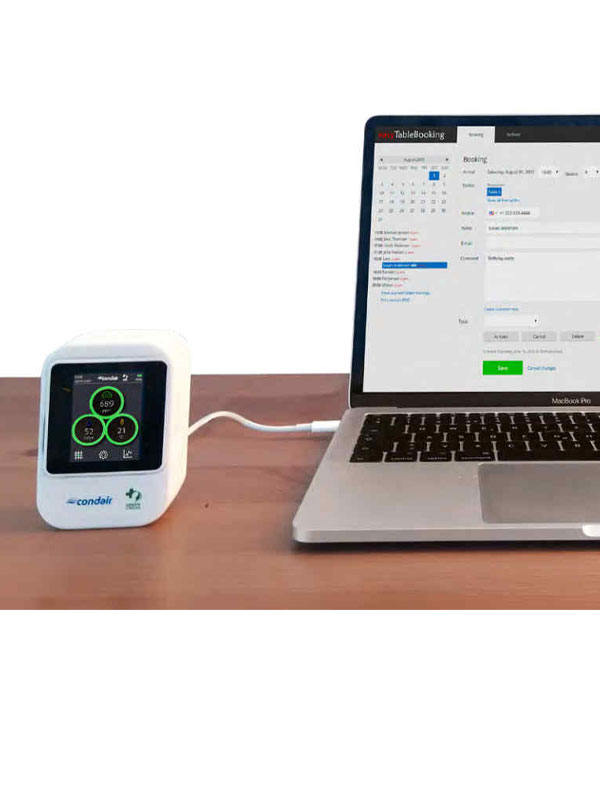
Connecting to a laptop? Get the app
Ordering in the UK is via our sales team only
You may also be interested in...

Humidity fights flu

What are the regulations on indoor humidity?

Return to work: how to manage a healthy humidity

My humidity is low, what should I do?

Humidity, health and wellbeing

Dry air and our airway defence system
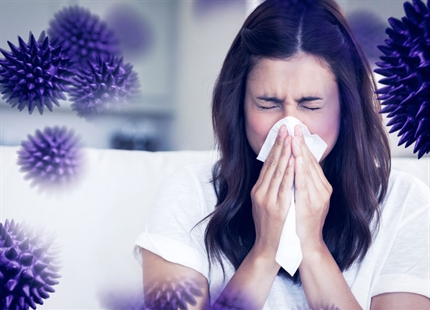
Dry air and airborne infection

Dry air and our skin
